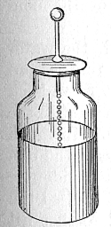Leyden jar
|
|

The Leyden jar was the original capacitor, developed in the 18th century and used to conduct many early experiments in electricity.
Description
The device was a glass jar coated inside and out with metal. The inner coating was connected to a rod that passed through the lid and ended in a metal ball. Typical designs consist of an electrode and a plate, each of which stores an opposite charge. These two elements are conductive and are separated by an insulator (e.g., the glass dielectric). The charge is stored at the surface of the elements, at the boundary with the dielectric.
History
Leidse_flessen_Museum_Boerhave_december_2003.jpg
The ancient Greeks used balls of amber on spindles that they rubbed to generate sparks. This is the triboelectric effect, mechanical separation of charge in a dielectric. Their work was a precursor to the development of the leyden jar.
Around 1650, Otto von Guericke built a crude friction generator - a sulphur ball that rotated at high speed on a shaft. When Guericke held his hand against the ball and turned the shaft quickly, a static electric charge built up. In 1745, another German, Ewald Jürgen Georg von Kleist, found a method of storing this charge. He lined a glass jar with silver foil, and charged the foil with a friction machine. Kleist was convinced that a substantial charge could be collected when he received a significant shock from the device. This invention went on to be known as the Leyden jar because in 1746, Pieter van Musschenbroek of the University of Leiden, Netherlands, independently made the same discovery. Musschenbroek made the storage jar known to the scientific world, hence the jar was named after Leiden, the home town of the university.
The physicist James Clerk Maxwell invented the concept of displacement current, dD/dt, to make Ampere's law consistent with conservation of charge in cases where charge is accumulating, for example in a Leyden jar. He interpreted this as a real motion of charges, even in vacuum, where he supposed that it corresponded to motion of dipole charges in the ether. Although this interpretation has been abandoned, Maxwell's correction to Ampere's law remains valid (a changing electric field produces a magnetic field). The displacement current must be included, for example, to apply Kirchhoff's current law to a Leyden jar.
The "dissectible Leyden jar" myth
A popular demonstration of the Leyden jar involves taking one apart after it has been charged and purportedly showing that the energy is stored on the dielectric, and not the plates:
A Leyden jar is constructed out of a plastic cup nested between two snugly-fitting metal cups. When the jar is charged with a high voltage and carefully dismantled, it is discovered that all the parts may be freely handled without discharging the jar. If the pieces are reassembled, a large spark may still be obtained.
This demonstration shows that the charge has been transferred to the surface of the dielectric, and is not on the metal conductors. When the jar is taken apart, simply touching the cup does not give you enough surface area to discharge it. The conductors provide this surface area.
This is not typical of capacitors, however, and doesn't happen at lower voltages. In a typical capacitor, the charge is on the surface of the conductors. It results from the high voltages present when the conductors are separated from the dielectric "spraying" charge onto the dielectric. If the experiment were performed in an insulating fluid (like oil) instead of air, the effect would no longer be present.
